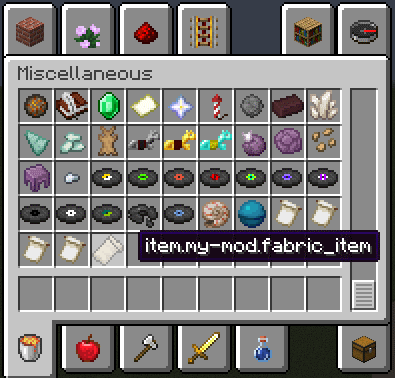Table of Contents
아이템 추가
소개
아이템을 추가하는 것은 모딩에 있어서 가장 첫 번째 단계입니다. 당신은 Item 오브젝트를 추가하고, 등록하고, 텍스쳐를 추가할 것입니다. 아이템의 추가적인 기능을 위해서는 커스텀 아이템 클래스를 만들어야만 할 것입니다. 모든 튜토리얼에서는 tutorial NameSpace를 사용할 것입니다. 다른 Mod ID를 사용하고 싶으시다면, 해당 부분을 수정하셔도 됩니다.
아이템 등록
먼저, 아이템의 인스턴스를 생성합니다. 해당 인스턴스는 Initializer 클래스의 맨 윗 부분에 저장합니다. Item.Settings (또는 FabricFirst) 가 인스턴스 생성자이며, 인벤토리 분류나 내구성, 한칸에 쌓일 수 있는 개수 등의 아이템 정보를 설정할 수 있습니다.
새로운 내용을 등록할 때는 바닐라 등록 시스템(레지스트리)을 사용할 것입니다. 기본적인 문법은 Registry#register(Registry Type, Identifier, Content) 입니다. Type은 기본적으로 Registry 클래스에 있으며, Identifier는 내용물을 설정합니다. Content는 당신이 추가하고자 하는 아이템의 인스턴스입니다. 이 함수는 Initialization 진행 중 언제든지 호출될 수 있습니다.
자, 이제 첫 번째 아이템이 Minecraft에 추가되었습니다. runClient Gralde task를 실행하여 살펴보세요.
아이템 텍스쳐 추가
텍스쳐를 추가하기 위해서는 아이템 모델 .json 파일과 텍스쳐 이미지가 필요합니다. 이것들은 resource 폴더에 저장될 것이며, 경로는:
아이템 모델: .../resources/assets/tutorial/models/item/fabric_item.json 아이템 텍스쳐: .../resources/assets/tutorial/textures/item/fabric_item.png
기본 예시 텍스쳐는 여기에서 찾으실 수 있습니다..
아마도 첫 번째 단계에서 아이템이 성공적으로 추가되었을 때, 게임에서 다음과 같이 텍스쳐를 찾을 수 없다는 오류를 내뱉었을 것입니다:
[Server-Worker-1/WARN]: Unable to load model: 'tutorial:fabric_item#inventory' referenced from: tutorial:fabric_item#inventory: java.io.FileNotFoundException: tutorial:models/item/fabric_item.json
It conveniently tells you exactly where it expects your asset[s] to be found– when in doubt, check the log.
가장 기본적인 아이템 모델 형식:
{ "parent": "item/generated", "textures": { "layer0": "tutorial:item/fabric_item" } }
Parent는 손에서 어떻게 아이템이 렌더링되는지를 정할 수 있으며, 이는 블럭 아이템과 같은 경우에서 유용하게 쓰일 수 있습니다. “item/handheld”로 설정하면 텍스쳐의 좌측 하단 부분을 손이 들게 됩니다. textures/layer0은 이미지 파일의 경로입니다.
최종적으로 텍스쳐가 적용된 아이템:
아이템 클래스 생성
아이템에 대해 추가적인 기능을 넣기 위해서는, 아이템 클래스를 생성하여야 합니다. 기본적인 클래스 생성자는 Item.Settings 오브젝트를 필요로 합니다.
아이템을 사용하면 소리가 나는 예시입니다:
원래의 Item 오브젝트를 새로 만든 아이템 클래스로 바꿔주세요:
여기까지 잘 따라왔다면, 아이템을 사용하였을 때 소리가 들릴 것입니다.
아이템이 한칸에 쌓일 수 있는 개수를 조절하고 싶으면?
여기서 우리는 쌓일 수 있는 개수를 조절하기 위해서 FabricItemSettings 안에 있는 maxCount(int size)를 사용할 것입니다. 만약 해당 아이템의 내구도가 존재한다면 이를 조정할 수 없으며, 게임에서는 RuntimeException 오류가 나올 것입니다.


